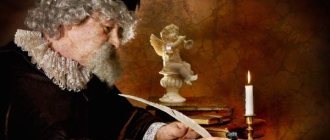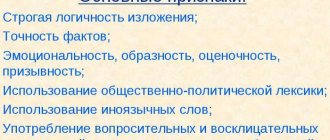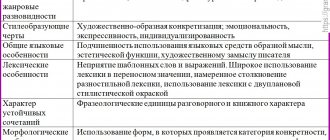!!!Try to write a comment in book style!!!
Greetings, dear readers!
Pavel Yamb is in touch. A captivating plot, an interesting presentation, an inimitable, unlike anything else style - and it is impossible to tear yourself away from the work. By all indications, this is an artistic style of text or a type of bookish style, since it is most often used in literature, for writing books. It mainly exists in written form. This is what causes its features. There are three genres:
- Prose: story, fairy tale, novel, story, short story.
- Dramaturgy: play, comedy, drama, farce.
- Poetry: poem, poem, song, ode, elegy.
Who hasn't done this yet? Leave any comment and download my book, which contains a fable, a parable and a story about copywriters and writers. Look at my art style.
Time limit: 0
Navigation (job numbers only)
0 out of 10 tasks completed
Questions:
- 1
- 2
- 3
- 4
- 5
- 6
- 7
- 8
- 9
- 10
Information
This test will show how well you understand text styles.
You have already taken the test before. You can't start it again.
The test is loading...
You must log in or register in order to begin the test.
You must complete the following tests to start this one:
results
Time's up
You scored 0 out of 0 points (0)
Categories
- No category 0%
Your result has been recorded in the leaderboard Loading
- 1
- 2
- 3
- 4
- 5
- 6
- 7
- 8
- 9
- 10
- With answer
- With a viewing mark
- Task 1 of 10
1.
What text style does this passage belong to?
- Yes, he spent the entire scholarship. Instead of buying a new computer, or at least a laptop
- Task 2 of 10
2.
What text style does this passage belong to?
“Varenka, such a sweet, good-natured and sympathetic girl, whose eyes always shone with kindness and warmth, with the calm look of a real demon, walked to the Ugly Harry bar with a Thompson machine gun at the ready, ready to roll these vile, dirty, smelly and slippery types into the asphalt, those who dared to stare at her charms and drool lasciviously. »
- Task 3 of 10
3.
What text style does this passage belong to?
- But I don’t love him, I don’t love him, that’s all! And I will never love you. And what is my fault?
- Task 4 of 10
4.
What text style does this passage belong to?
“Based on the results of the experiment, we can conclude that simplicity is the key to success”
- Task 5 of 10
5.
What text style does this passage belong to?
“The transition to a multi-tier architecture of Internet-oriented client-server applications has confronted developers with the problem of distributing data processing functions between the client and server parts of the application.”
- Task 6 of 10
6.
What text style does this passage belong to?
“Yasha was just a small dirty trickster, who, nevertheless, had very great potential. Even in his pink childhood, he masterfully stole apples from Aunt Nyura, and not even twenty years had passed before, with the same dashing fuse, he switched to banks in twenty-three countries of the world, and managed to peel them so skillfully that neither the police nor There was no way Interpol could catch him red-handed. »
- Task 7 of 10
7.
What text style does this passage belong to?
“Why did you come to our monastery? - he asked.
- What do you care, get out of the way! – the stranger snapped.
“Uuuu...” the monk drawled meaningfully. - Looks like you weren't taught any manners. Okay, I'm just in the mood today, let's teach you a few lessons.
- You got me, monk, hangard! – the uninvited guest hissed.
– My blood is starting to play! – the churchman moaned with delight, “Please try not to disappoint me.”
- Task 8 of 10
8.
What text style does this passage belong to?
“I ask you to grant me a week’s leave to travel abroad for family reasons. I am enclosing a certificate regarding my wife's health. October 8, 2012. »
- Task 9 of 10
9.
What text style does this passage belong to?
“I am a 7th grade student who took the book “Alice in Wonderland” from the school library for a literature lesson. I undertake to return it on January 17th. January 11, 2021"
- Task 10 out of 10
10.
What text style does this passage belong to?
“During the war in the village. Borovoe, 45 houses out of 77 survived. The collective farmers had 4 cows, 3 heifers, 13 sheep, 3 piglets. Most of the gardens on personal plots, as well as an orchard with a total area of 2.7 hectares belonging to the Krasnaya Zarya collective farm, were cut down. The damage caused by the Nazi invaders to the property of the collective farm and collective farmers is estimated at approximately 230,700 rubles.”
maximum of 100 points
| Place | Name | Recorded | Points | Result |
| Table is loading | ||||
| No data | ||||
My other tests
The ability to write in this style gives a good advantage when making money by writing articles for a content exchange.
Main functions
People created literary texts many centuries ago. Such works were special; they conveyed how the author sees reality. Over time, the techniques developed and improved, but the function of the style remained the same. It was intended to convey to the reader the author's vision of the world - real or fictional.
Initially, the word “style” (obsolete “stele”) meant a thin stick for writing or creating graphics. Subsequently, this became the name for a pencil. Thanks to style, the writer receives unlimited opportunities to express the subtlest shades of meaning, convey his thoughts and evoke a certain emotional state in the reader. Within this direction, the author enriches written speech with means of expressiveness. Social functions performed by style:
- Impacting. The work makes you empathize, be indignant, rejoice and experience other emotions.
- Communicative. The author of works of fiction, unlike a publicist, addresses not a faceless audience, but “his” reader, with whom he speaks the same language. A kind of dialogue ensues between the author and the person reading the book. The writer conveys his vision of the world and expects understanding.
- Informative. From literary texts, people receive a lot of information about the causes and consequences of phenomena and events, the laws of the development of the world, the moral laws by which relationships between people are built, and much more.
- Aesthetic. This function subordinates the others. The author reproduces reality in the text using a complex system of images (people, things, phenomena, etc.).
The purpose of style is to evoke certain emotions in the reader. They can be achieved if the work fulfills its functions. There are only three of them:
- Figurative-cognitive. Using the emotional component, the writer talks about something. The reader understands the world using the system of images proposed by the author.
- Ideological and aesthetic. The transmission of the main thoughts and ideas of the work is carried out through a colorful description of images.
- Communicative. It is about finding common ground between the fictional and real worlds. If the reader succeeds, then the author has coped with the task.
Must-have wardrobe items for a Parisian woman.
Many representatives of the fair sex, who strive to look stylish and sophisticated every day, have a set of basic, must-have items in their wardrobe. What kind of items can be found in a Parisian woman's closet?
1. Ballet shoes. Contrary to popular belief, French women do not always prefer shoes with heels. In everyday life they wear comfortable ballet shoes with thin soles.
2. Bag with a long strap. A handbag thrown over one shoulder is a habit of a large number of residents of the fashion capital.
3.Large size scarf. Residents of many countries prefer a variety of voluminous scarves. However, most Parisian women believe that this is an irreplaceable and absolutely necessary accessory during the cold season.
4. A fitted jacket, raincoat or jacket. A truly French style is to wear fitted jackets. They are decorated with thin straps or worn wide open.
5.Large sunglasses. In combination with hair pulled back into a tight ponytail, bun or updo, these glasses look especially stylish and sophisticated.
6. Clothing in black. For Parisian women, black is not the color of mourning. For them, he is the personification of style and grace. Therefore, to create a Parisian look, you need to have black T-shirts, T-shirts, sweaters and other items of clothing in your wardrobe.
Area of use
This style is used when you need to create a beautiful, convincing and emotionally rich text. It is mainly used in writing, and in oral speech this direction appears when a play is staged based on a literary work. Literary scholars identify several groups of genres within which it is appropriate to use artistic style:
- Lyrics. Lyrical works are characterized by an abundance of means of expression. They convey the thoughts and experiences of the author.
- Epic. The author not only expresses his thoughts, but also talks about events. An epic contains one or more storylines.
- Drama. The author's presence here is minimal. Most of the dramatic work consists of the characters' statements.
Epic, lyric and drama are divided into subtypes, each of which uses the style in a special way. List of genres classified as epic:
- Novel. Works created in this genre cover large periods of time, describing the life of one or several generations. They are characterized by the complexity of the plot. The narrative touches on the inner world of the characters and external events.
- Story. The plot is limited to an incident that happened to one or more characters. The story size is usually small.
- Tale. It combines the characteristics of a story and a novel and is medium or small in size. The author narrates the lives of the characters, adhering to chronological order and without delving into their inner world.
- Epic. This work focuses on significant historical events.
Lyrics are also divided into several genres. As a rule, these are poetic works, but there are exceptions when the author chooses a prose form. Lyrical genres of artistic style:
- Elegy. A work with a lyrical orientation, clothed in poetic form.
- Sonnet. A rhymed work consisting of 14 lines. In a sonnet, rhyming is done in a certain way. Examples can be found in Shakespeare, who was an unsurpassed master of this genre.
- Oh yeah. A poetic text dedicated to a famous person or significant event.
- Epigram. A work that contains rhyme. The focus is humorous or satirical. An excellent example of how artistic style is used when writing is the work of A. S. Pushkin “Epigram on M. S. Vorontsov.”
Among the dramatic genres, there are more famous ones and those that are now almost forgotten. Here is their brief description:
- Tragedy. The author tells about the life of the heroes, filled with tragic events. Special attention is paid to character portraits.
- Drama. The work shows the life of not only individual characters, but also the entire society or a separate part of it. The difference between drama and tragedy is social significance.
- Comedy. Here the author not only talks about things, events or phenomena, but also actively ridicules them. Often comedies show human flaws, weaknesses or vices.
Each genre has its own task. So, comedy is fun, but also makes you think, look at yourself from the outside. Drama evokes compassion and excitement in the soul. Tragedy, depending on the context, can inspire sympathy towards the heroes or indignation directed at their offenders. Depending on what mood needs to be created, the author chooses the means of artistic expression. Much depends on the personality of the writer, on whether he is a science fiction writer or a realist (adherent of realism).
Signs of artistic style
Over time, signs of an artistic style were developed. The main one is the presence in the text of techniques that can awaken certain emotions and evoke the right mood. Literary text not only informs, it is designed for feedback. The reader enjoys the play on words, the richness of speech and the beauty of sentences. Figures of speech used by the authors:
- hyperbola;
- comparison;
- metaphor;
- epithet;
- allegory.
Another sign is the frequent use of words that have more than one meaning. Thanks to this, semantic nuances and depth are formed. The reader may return to the same passage several times, discovering new meaning. Synonyms are also used - words with similar but not identical meanings. With their help, the text acquires new facets and has an aesthetic impact on the reader.
The peculiarity of the artistic style is that it allows colloquial, colloquial and other expressions that are not applicable, for example, in journalism or scientific works. Over the years, each author develops his own unique style, thanks to which readers unmistakably distinguish his works from the creations of other writers.
Expression and emotionality are two more features inherent in artistic style. It is important that the same words in a journalistic text can have a neutral connotation, but in a literary text they can have a certain emotional characteristic.
An interesting technique used when creating dramatic, lyrical and epic creations is inversion. Its essence is that words in sentences are not placed in the usual order, but differently. Due to this, the desired mood is achieved.
Structural norms that must be observed in scientific and journalistic texts may be violated in works of art if this is the author’s intention. Deviations are explained by the fact that the writer wants to focus the reader’s attention on a separate thought or idea. Types of rules that can be violated:
- morphological;
- lexical;
- phonetic.
We can say that this style dominates the others, because it has absorbed all the techniques and means used by the authors. It surpasses the others in brightness, richness and saturation.
Verbal speech studies (plot studies) deserve special attention. It consists in the fact that the author names each action in order to enhance the effect of what is said: “We walk, we crumple, we trample into the mud.” Thanks to this technique, it is possible to convey dynamics and growing tension, as well as show how the situation changes over time. The reader continuously follows the plot, while the author seems to guide him through the text, preventing him from getting distracted.
Considering how many features distinguish a work of art, the reader can easily distinguish it from other types of texts. If the task is to determine the style, first you need to understand what genre the creation belongs to. After this, with almost 100% probability it will be possible to say whether the work is in artistic style or whether it represents journalism, analytics, scientific work, and so on.
Main features of the artistic style
High emotionality, the use of direct speech, an abundance of epithets, metaphors, colorful narration - these are the features of the literary language. Texts influence the imagination of readers, “turning on” their fantasy. It is no coincidence that such articles have gained popularity in copywriting.
Main features:
- imagery in the depiction of reality;
- the author's position is expressed using artistic images;
- emotionality of the story;
- expressiveness of presentation;
- individual author's style;
- speech portraits of characters (vivid verbal characteristics).
Artistic style is the author’s way of self-expression; this is how plays, poems and poems, stories, short stories, and novels are written. He is not like the others.
- The author and the narrator are one person. In the work, the author’s “I” is clearly expressed.
- Emotions, the mood of the author and the work are conveyed using the entire wealth of language. Metaphors, comparisons, phraseological units are always used when writing.
- Elements of conversational style and journalism are used to express the author's style.
- With the help of words, artistic images are not simply drawn; hidden meaning is embedded in them, thanks to the polysemy of speech.
- The main task of the text is to convey the author’s emotions and create the appropriate mood in the reader.
The artistic style does not tell, it shows: the reader feels the situation, as if transported to the places that are being narrated. The mood is created thanks to the author's experiences. The artistic style successfully combines explanations of scientific facts, imagery, attitude to what is happening, and the author’s assessment of events.
Examples of texts
This style can be found everywhere. It is present in poems, stories, novels, novellas. Every author has his favorite techniques. For example, some actively use detail, while others saturate the text with epithets. An example of a text with an artistic style of speech, emphasized by detail: “The soldier walked briskly along the white sand, warmed by the scorching rays of the sun. All his clothes were wet, and his skin showed red marks left by the barbed wire. An aching pain permeated his whole body, but he walked, gathering his last strength, because the headquarters was already visible in the distance.”
This passage shows the physical suffering of a soldier, and the author pays attention to details that allow the reader to understand what the character is going through. The second passage is an example of how epithets can be used: “The little mischief maker Yasha was not just a tomboy, but a child with great potential. One only has to remember how masterfully he cleaned out Baba Zina’s garden. As he grew up, he became just as skilled at stealing money from banks. The fraudster managed to act so cleverly that he was never caught in the act.”
Tip 2: Distinctive features of the style of a resident of Paris
Since ancient times, France has been considered not just a country whose residents have exquisite taste. She was a trendsetter. In Paris, as in the very heart of the country, even its own special style has been formed.
When talking about Parisian women, many people imagine a sophisticated woman with impeccable hair and impeccable makeup. She is wearing high-heeled shoes and elegant business clothes. The lady is surrounded by a halo of the aroma of expensive perfume, and her gaze is directed into the distance. So what is it, Parisian style?
Application in other forms of art
The artistic style is used in various forms of art, including painting. However, artists do not use it in its pure form, but combine different directions. In addition, in the visual arts there is a tendency to constantly change styles: some flow into others, merge with others and acquire new features.
In the process of painting an oil painting or creating a graphic design, modern European and Asian artists do not limit themselves to traditional means. Often they stylize their works so strongly that they violate cultural norms. This is typical for fashion masters of the current era. Artistic directions in painting:
- baroque;
- classicism (classical);
- Revival;
- Gothic;
- purism;
- cubism;
- naturalism;
- abstract art (abstract);
- urbanism (urbanistic);
- impressionism;
- geometry (geometric).
Within each direction, researchers name prominent representatives. So, in impressionism it is Claude Monet, in cubism it is Pablo Picasso, in urbanism it is Edward Hopper, in naturalism it is José Julio de Souza Pinto.
When talking about style, researchers usually mean 2 meanings: global and narrow. In the first case, we are talking about a set of tools and techniques that involve repeatability. In a narrow sense, style is the individual handwriting of the master, which can be traced in every creation. The situation is similar in architecture, music, theater, cinema and other forms of art.










